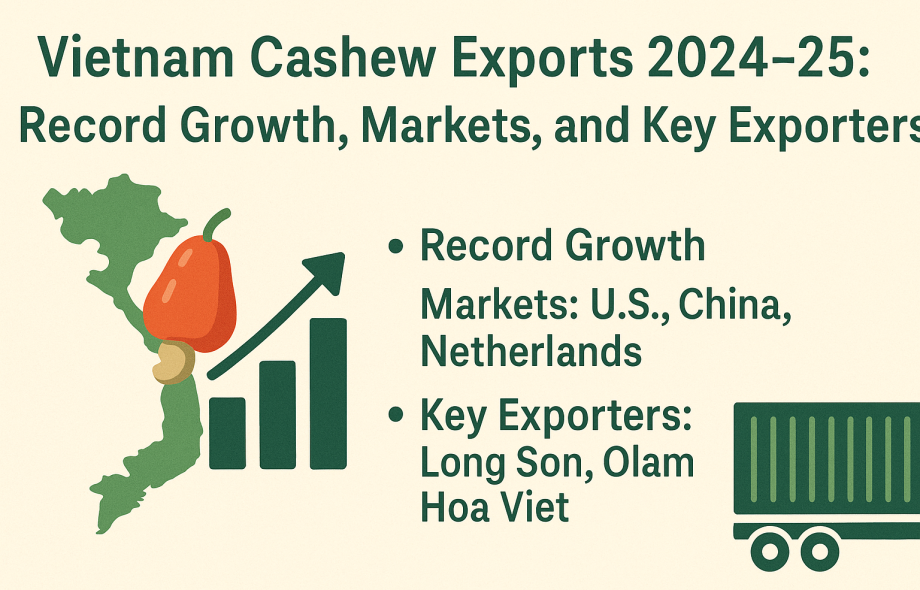Vietnam has long held a dominant position in the global cashew industry, and the 2024–25 export cycle has only strengthened its reputation. With exports surging to a record $4.37 billion, Vietnam continues to lead the world in cashew kernel production and exports, thanks to its expansive supplier base, technological investment, and global market reach. As of 2024, the country commands over 80% of the world’s processed cashew exports, firmly establishing itself as a cornerstone of the international nut trade.
This remarkable performance is backed not only by sheer volume but also by strategic agility, product diversification, and sustained investment in modern processing infrastructure. This guest post delves into the Vietnam cashew exports landscape, examines the top export markets, key exporter profiles, and also highlights insights from Vietnam import data that impact the upstream segment of this critical agro-export sector.
Vietnam Cashew Exports in 2024: Record Volumes, Higher Prices
According to the latest Vietnam cashew export data, the country exported 730,000 metric tons of cashews in 2024, a 13.3% increase from 2023. Export value soared to $4.37 billion, eclipsing the previous high of $3.63 billion in 2021. The average export price per ton rose to $6,003, reflecting increased global demand and a shift toward premium-grade kernels such as W180 and W240.
This growth trajectory is not an accident but the result of deliberate policy, investment, and market positioning. Vietnam’s government and industry body Vinacas have aggressively supported the development of high-quality processing plants, upgraded technologies, and the standardization of exports to meet stringent international regulations.
Top Destinations for Vietnam Cashew Exports
Vietnam’s cashew exports reach over 150 countries, but the top 10 destinations account for the majority of trade. The United States leads the list with imports worth $660.53 million, followed by China at $466.52 million, and The Netherlands at $351.39 million.
-
USA: The U.S. remains Vietnam’s largest customer, although a 10% import tariff in early 2025 has caused a 14.5% drop in Q1 shipments. U.S. buyers favor whole white kernels (WW240/WW320), often purchased by private-label snack brands and organic food retailers.
-
China: The Chinese market showed an astonishing 58% volume growth in 2024. Chinese consumers prefer broken or snack-flavored cashews, indicating a significant opportunity for flavored and value-added products.
-
EU Nations (Netherlands, Germany): These countries are key entry points into the broader European market, especially for organic, fair-trade, and sustainably sourced cashews. The Netherlands alone recorded a 12% YoY increase in volume.
-
Emerging Markets (Turkey, UAE, Saudi Arabia): Turkey recorded the fastest growth rate among the top ten with an 80% increase in volume, while the UAE plays a dual role as a consumer and a re-export hub to other Gulf countries.
Top Cashew Exporters in Vietnam
Vietnam is home to over 7,500 exporters and suppliers in the cashew industry, with the top 10 exporters accounting for nearly 40% of the trade value. Some key players include:
-
Visimex Corporation: $430 million in exports (74,000 tons)
-
Hoang Son Co.: $395 million (68,000 tons)
-
CPT Corporation: $370 million (65,000 tons)
-
Phuc An Cashew JSC, Lafooco, and My An Cashew Nut also contribute significantly to global supply.
These companies are well-known for their quality assurance, sustainability practices, and export compliance, making them trusted partners for international buyers.
Vietnam Import Data: Raw Cashew Inputs Fuel Export Output
While Vietnam is a cashew export powerhouse, its raw material supply chain is heavily dependent on imports. According to Vietnam import data, the country imported over 2.5 million tons of raw cashew nuts in 2024, primarily from Ivory Coast, Nigeria, and Cambodia, with a total import value exceeding $3 billion.
The imported raw cashew nuts are processed in over 500 medium and large-scale processing facilities, mainly located in Binh Phuoc, Dong Nai, and Binh Duong provinces. This strategic import system allows Vietnam to maintain high output volumes even with domestic cultivation covering just 316,100 hectares, yielding 348,000 tons in 2024.
This interdependence of export and import data highlights Vietnam’s processing-led growth model, wherein raw imports are transformed into premium-grade kernels for global markets. The ability to import, process, and re-export at scale is a core advantage in Vietnam’s cashew value chain.
Market Trends: Premiumization and Diversification
One of the standout trends in Vietnam cashew exports is the shift to premium products. In 2024, whole and high-end grades (W180/W240) represented 63.5% of export volume and 70% of turnover. This reflects growing global demand for luxury-grade nuts among health-conscious consumers and gourmet brands.
Additionally, markets are diversifying. Even as the U.S. imposed tariffs, countries like Japan, Turkey, and Australia recorded double-digit growth in imports. This resilience underscores Vietnam’s ability to navigate trade disruptions and reallocate supply based on evolving global demand.
Challenges Facing Vietnam’s Cashew Industry
Despite stellar growth, Vietnam’s cashew industry faces several headwinds:
-
Tariff barriers: The newly imposed 10% tariff by the U.S. in 2025 has impacted trade volume significantly.
-
Raw material dependency: Over-reliance on imports exposes Vietnam to geopolitical and supply chain risks.
-
Rising costs: Higher processing and freight costs have squeezed profit margins.
-
Shrinking domestic area: While 2024 saw a rebound to 316,100 hectares, the area is still below 2020 levels, with crops like durian offering better returns per hectare.
2025–26 Outlook: Optimism with Caution
Looking ahead, Vietnam’s cashew sector is poised to maintain its leadership, but with a clear emphasis on value over volume, diversified markets, and sustainable sourcing. Strategic goals include:
-
Expanding domestic raw nut production.
-
Leveraging agro-digital technologies like high-yield seeds and blockchain traceability.
-
Investing in branded, value-added cashew products to reduce reliance on bulk exports.
According to industry projections, the global nut market will grow from $8.14 billion in 2024 to $11.7 billion by 2033, offering a strong tailwind for Vietnamese exporters.
Final Thoughts: Why Vietnam Cashew Exports Matter
Vietnam’s success in cashew exports is a powerful example of how agro-processing, strategic sourcing, and market intelligence can transform a commodity into a high-value global product. The integration of Vietnam import data into the production chain ensures raw material availability, while export excellence helps drive economic growth and rural employment.
For importers, distributors, and investors, understanding Vietnam’s cashew landscape is crucial to tapping into this high-growth, high-quality market. Whether sourcing from industry leaders or exploring new destinations, the future of Vietnam cashew exports looks bright.
 :
https://in.pinterest.com/tradeimex
:
https://in.pinterest.com/tradeimex

